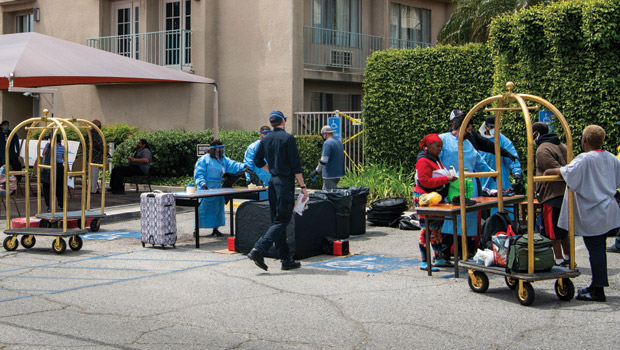Pandemic pinpoints racial, ethnic disparities
Disparities in outcomes created by COVID-19 have exposed long-standing gaps in health care, and in a larger sense, the fabric of the social safety net.
The virulence of COVID-19 has propelled already percolating discussions about racial disparities in health and racism in health care to the forefront.
Repeatedly, studies have highlighted that people of color are far more vulnerable to the virus:
- In the Washington, D.C., area, nearly 43% of the 6,162 patients who tested positive for the virus at Johns Hopkins Health System March 11 through May 25 were Latino. Nearly 18% were Black and 8.8% were non-Hispanic white, according to a study published online June 18 in JAMA.
- In Louisiana, 76.9% of patients hospitalized at New Orleans-based Ochsner Health were Black, although Black patients typically make up 31% of the nonprofit health system's patient population, researchers reported June 25 in the New England Journal of Medicine.
- Among all racial and ethnic groups, Native Americans and others of Indigenous background are the most vulnerable to COVID-19—more than five times more likely to be hospitalized than non-Hispanic whites based on the latest CDC analysis of data through mid-June.
Numerous factors likely play a role in why Blacks, Latinos, and Native Americans are more likely to contract COVID-19 and to become severely ill, according to researchers and physicians striving to reduce health disparities. Individuals who live in close housing quarters or work front-line jobs requiring a lot of interpersonal interaction—from retail to meat packing plants to health care—have more difficulty avoiding a contagious virus. These ethnic and racial groups also face a greater risk of developing diabetes, hypertension, obesity, and other conditions that have been linked to a higher likelihood of severe illness.

But those factors are inherently intertwined with other inequities that these communities have coped with for decades: substandard housing conditions, inadequate to nonexistent insurance, and food deserts, among other systemic differences. In a policy statement published June 19 by Annals of Internal Medicine, ACP called out racism and discrimination in the U.S. and, among its recommendations, committed to condemn and oppose “racist policies and actions that perpetuate injustices and inequities in medicine and throughout all aspects of U.S. society.”
“What the virus is highlighting and how it has tested our systems and how it has tested us as people is what we have neglected to do and what we have neglected to take care of for many, many, many years,” said Eileen Barrett, MD, MPH, FACP, a hospitalist at University of New Mexico Hospital in Albuquerque, who has been treating COVID-19 patients from the nearby Navajo Nation in recent months. “And what we have oftentimes neglected to see, willfully at times, and I think unconsciously at times.”
COVID-19 has exposed long-standing gaps not just in health outcomes but in the fabric of the social safety net, said ACP Member Krystal Chan, MD, an assistant professor in the department of internal medicine at the University of New Mexico Health Sciences Center in Albuquerque.
“I feel like it's the little scar that got picked and opened up a gaping wound,” said Dr. Chan, who describes herself as first-generation Mexican Yucatec Mayan. “And I feel that a lot of Latinx, Black, or Indigenous providers already knew this, because we come from these communities.”
A viral vulnerability
The NEJM analysis, which looked at outcomes for 3,481 COVID-19-positive patients who were seen at Ochsner Health between March 1 and April 11, found that Black patients had a higher prevalence of obesity, diabetes, hypertension, and chronic kidney disease than non-Hispanic white patients. Black patients were more likely to present with fever, cough, and other symptoms. They also were far more likely than white patients to be tested for the virus in the ED—65.3% versus 38%.
Those differences raise “a question of access to care and delayed presentation,” said Eboni Price-Haywood, MD, MPH, FACP, the study's lead author and director of the Center for Outcomes and Health Services Research at Ochsner Health. “For both of those possibilities, the question is why? And why would one particular group be disproportionately represented in that?”
At least some of the answers might be found in other disparities identified in the NEJM analysis. Black patients with the virus were three times more likely to be on Medicaid and nearly two times more likely to live in a low-income area than non-Hispanic white patients. Rather than working remotely from a home computer, Black residents in the New Orleans region are more likely to be employed by health facilities or to hold retail positions and other jobs that make social distancing infeasible, Dr. Price-Haywood said.
Hispanics/Latinos are similarly likely to work front-line jobs, said Elena Rios, MD, MSPH, FACP, president and CEO of the National Hispanic Medical Association in Washington, D.C. In addition to increasing the risk of exposure, financial pressures from such jobs, including sometimes a lack of sick days, can discourage people from seeing a doctor even when worrisome viral symptoms flare, she said.
“They don't want to lose their job, so why get tested?” Dr. Rios said. “If they get tested and find out that they're positive, then they have to tell their employer and they can lose their job.”
In some Latino families, whether by choice or financial necessity, people may live in close quarters that makes self-quarantining impossible if someone becomes ill, Dr. Rios said. Also, several generations may be under one roof, with differing legal status, she said.
Thus, families tend to steer clear of publicly-funded programs, from free or reduced school lunches to Medicaid, fearing that interactions with officials could inadvertently lead to a loved one's deportation, Dr. Rios said. “That's also why they don't go to the emergency room or go to the doctor.”
Bridging the disparities gap
Aaron Price, MD, who practices at Tséhootsooí Medical Center in Fort Defiance, Ariz., said the structure of the community has complicated efforts to limit outbreaks as extended families often live under one roof or clustered in nearby housing and gather for meals and celebrations. “It's helpful in that it allows the family to stay connected and grounded,” said Dr. Price, who is Navajo and grew up in Fort Defiance. “But in COVID times, that's just a recipe for disaster to spread the virus.”
Tracing cases once someone is diagnosed has proven difficult, given that cell phone service is spotty and most residents don't have physical addresses, but rather use post office boxes, Dr. Price said. That lack of addresses also makes it difficult to deliver durable medical equipment, such as hospital beds.
In June, Dr. Price postponed discharging a COVID-19 patient after getting more insight into his home setup. The man said he had electricity, required for his oxygen equipment. But upon further questioning Dr. Price learned that he relied upon an extension cord running from a neighbor's home.
Too often doctors make assumptions based on their own personal experience, Dr. Barrett said. For instance, the common pandemic guidance to wash one's hands for at least 20 seconds doesn't help communities where running water isn't reliable. Neither is it easy to shop for healthy food in a region like the Navajo Nation, which has roughly a dozen grocery stories in a stretch of land the size of West Virginia, she said.
Dr. Barrett advises physicians to develop health strategies and language that may be more practically and culturally appropriate for their patients. She shared an educational sign designed for Navajo Nation residents, which shows two sheep standing end to end to depict the minimum distance required for social distancing. Given the lack of running water in some areas of the Navajo Nation, Dr. Chan said, residents were taught to stir bleach into communal washing bowls to create a more sterile hand-washing solution.
Patients aren't necessarily going to offer up reasons why they can't follow the physician's recommendations, regardless of whether their diagnosis is COVID-19 or a more routine medical concern, Dr. Chan said. A question she likes to ask is, “What is a barrier to you being able to follow through with this treatment plan?”
When feasible, Dr. Chan may ask the patient for permission to update a family member, preferably someone younger. Some older Latino patients don't want to admit to money problems or other obstacles, she said.
“‘I can't pay my electricity bill.’ How embarrassing is it to admit that to a professional?” Dr. Chan said. “There is a huge power dynamic there. You're telling me that I need to do this. Of course, I'm going to say, ‘Yes. I'm going to do it.’”
Revisiting practices
In its June policy statement, ACP delineates how racial discrimination has played a role not only in everything from housing to the workplace to law enforcement but also in medicine. Along with referencing higher levels of mistrust among people of color, rooted in atrocities such as the Tuskegee Study of syphilis involving Black men, ACP also describes its own shortfalls. The College didn't have a Black member until after 1947, the statement noted, and leadership through the years has “largely been the domain of White physicians.”
Unfortunately, the viral course of COVID-19 can amplify mistrust of the medical system, Dr. Barrett said. Sometimes patients are not sick enough to need to be hospitalized and are sent home from the ED or urgent care, she said. But then their symptoms may worsen later, and it can feel to patients like they weren't treated well. “What we know about COVID is that it gets worse in the second week,” she said.
As physicians strive to become more attuned to addressing health disparities, Dr. Barrett suggests that they look around their own practices and the facilities where they practice. Do they have access to enough interpreters? Are the signs posted on the walls or the paperwork at the front desk written in a way that they can be understood?
Other potential issues may be trickier to resolve. ACP Member Utibe Essien, MD, MPH, an assistant professor of medicine at the University of Pittsburgh School of Medicine who studies health disparities, said that he doesn't “believe that docs are explicitly biased against their patients.” But there's plenty of research to show that implicit bias can influence treatment recommendations, along with data showing that racial and ethnic concordance between doctor and patient can improve decision making, he said.
For some patients, that concordance is hard to find. Among active physicians, just 5% identify as Black, 5.8% as Hispanic/Latino, and 0.3% as Native American or Alaska Native, according to data from the Association of American Medical Colleges. Those racial or ethnic groups comprise, respectively, 13.4%, 18.5%, and 1.3% of the U.S. population, according to census data. Thus, both increased racial awareness and diversity of clinicians are required to help combat disparities, both during the pandemic and moving forward.
“I think it does go back to trust, and trust in the health care system,” Dr. Essien said. “As a Black doctor myself, there are still patients who relate to me, who love telling me, ‘I've never had a Black doctor before.’ They still are wary of the health system more broadly.”



